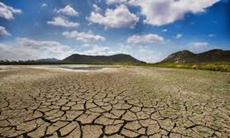Mega-drought lasting 35 years to hit US, warn scientists
13 Feb 2015
If people do not take action to rein in climate change by curbing fossil fuel use, long-lasting mega-droughts are increasingly likely in the western US later this century, researchers said on Thursday.
 A mega-drought is defined as one that lasts for 35 years or more.
A mega-drought is defined as one that lasts for 35 years or more.
The study led by experts at the Earth Institute at Columbia University is the first to predict that the coming intense dry spells could exceed the decades-long mega-droughts that occurred centuries ago and are blamed for the demise of certain civilizations in the late 13th century.
The risks and dangers are worse today because of the larger population and greater dependence on water resources, the scientists warned.
"We are the first to do this kind of quantitative comparison between the projections and the distant past, and the story is a bit bleak," said Jason Smerdon, a co-author and climate scientist at the Lamont-Doherty Earth Observatory, part of the Earth Institute at Columbia University.
"Even when selecting for the worst mega-drought-dominated period, the 21st century projections make the mega-droughts seem like quaint walks through the Garden of Eden."
Researchers applied 17 different climate models to analyse the future impact of rising temperatures on regions from Mexico to the United States and Canada.
They also projected a continued rise in emissions of the greenhouse gases that contribute to global warming, and looked at a scenario in which actions were taken to cut back on greenhouse gases resulting in lower emissions. Both approaches raised concern for the future.
"The results ... are extremely unfavourable for the continuation of agricultural and water resource management as they are currently practiced in the Great Plains and south-western United States," said David Stahle, professor in the Department of Geosciences at the University of Arkansas who was not involved in the study.
Currently the western United States has been experiencing a drought for about 11 of the past 14 years. The dry area spans California, Nevada, New Mexico, Arizona, Texas and Oklahoma and other parts of the region, and directly affects more than 64 million people.
The research was presented at the annual meeting of the American Association for the Advancement of Science, and published in a new AAAS online journal called Science Advances.

.webp)
.webp)

.webp)

.webp)


























